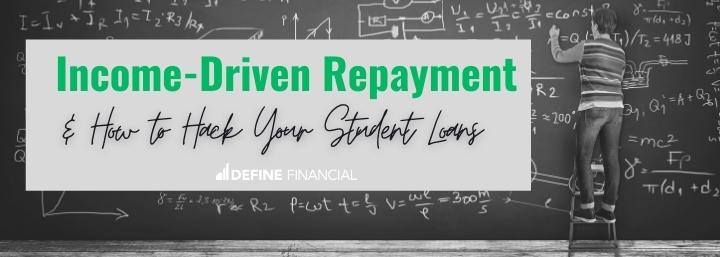
Student loans got you down?
If so, you can get in line with the other 44 million Americans.
Fortunately, there are a few strategies you can use to lower your income-driven student loan payments (aka income-driven repayment) and save buckets of money, too!
Here’s how it’s done.
What is an Income-Driven Repayment Plan?
In case you don’t know what I’m talking about here, income-driven repayment plans are government-backed plans that let borrowers pay back a percentage of their “discretionary income” toward their student loans for up to 25 years.
Once their program is up, their remaining loan balances will be forgiven.
The only caveat to note here is that, with income-driven repayment plans, you do have to pay income taxes on forgiven loan amounts during the year they were forgiven.
However, most borrowers can still come out way ahead even after paying the income tax that final year. It just takes some strategy.
Max Out Employer-Provided Retirement Plan
An easy first step to lowering your income-driven student loan payment is to put the maximum into your traditional 401(k), 403(b) or 457 plan. If you’re under age 50, you can sock away $19,500 in 2020.
You may be wondering if this makes any sense at all. After all, wouldn’t putting money into your 401(k) mean you have less cash to make your student loan payment?
Not exactly.
This is because your income-based repayments are based on your adjusted gross income (AGI). This is the amount of income you’re taxed on after taxable deductions.
And guess what? Contributions to your 401(k) are taxable deductions.
Smaller Loan Payments, Fewer Taxes, and Saving for Retirement
When you put money into a traditional 401(k) or traditional 403(b), your adjusted gross income goes down. And since your income-based repayments are based on your adjusted gross income (and not your gross income), you may qualify for smaller payments with your income-based repayment plan.
As an added bonus, you’re saving for retirement when you put money into these kinds of accounts. As a third benefit, putting money into a traditional 401(k) or traditional 401(b) means you’ll be paying less in taxes that year, too.
You may also be able to get free money from your employer when you fund your 401(k) account. This is because many employers offer matching funds for workers who contribute to their retirement accounts.
Four Benefits of Maxing Out Your 401(k) With Income-Based Repayment
This is such a big deal that I really feel I need to break it down again. When you put money into your traditional 401(k), etc., you:
- Save money on taxes
- Score a smaller income-driven repayment payment
- Save for retirement
- Potentially get free money from your employer
Let’s say it again: Fewer taxes, free money, a smaller income-based repayment, and saving for retirement! It’s a quadruple win.
Still, there’s one variable to note here – the difference between saving in traditional or Roth retirement accounts.
Normally, we’d advise clients to only ever contribute to Roth accounts and not to traditional retirement accounts. However, this can mean giving up the benefit of lower income-based repayments.
So, if the option is to not save in any retirement account at all because the college payments are so punishing, or save in traditional retirement accounts, I’ll choose the second option every day of the week.
Max Out a Traditional IRA
Just like maxing out a traditional retirement plan lowers your adjusted gross income, your income-based repayment, and the taxes you owe Uncle Sam (and possibly the state government), putting money into traditional IRA can do the same things.
You can lower your taxes, save for retirement, and decrease the amount going towards income-based repayments if you put money into a traditional IRA (and your income is low enough you can deduct the full amount on your taxes).
Max Out a Health Savings Account
When you max out a health savings account (HSA), you get all the benefits above and then some.
Putting money into an HSA means you’re using a high deductible health plan (HDHP). This means you’ll be paying less for the cost of health insurance.
You may also be able to save money on payroll taxes if you make HSA contributions through your employer via automatic paycheck deductions.
Go For the Trifecta to Lower Your Student Loan Payments
Imagine you wanted to use all the strategies listed above – investing in an HSA, traditional IRA (assuming certain income limits), and a traditional 401(k).
Contributing to all of these accounts will lower your adjusted gross income and help you pay less in taxes.
Even better, contributing to these accounts when you are on income-driven repayment plan helps you pay less toward your student loan bills, too.
To sum things up, going for the trifecta can benefit you in more than one way:
- It reduces your taxable income, meaning you will pay less in taxes. This will save you considerable sums of money each year you contribute to these accounts.
- If you’re using an HSA, it means you have an HDHP – which on average will save you money on the cost of health insurance each year that you use it.
- You get the benefit of saving for retirement, which is something that most people don’t do enough of.
- Each of these accounts grows tax-deferred. This means that, while your money grows inside the account, you pay zero taxes.
- You can decrease the amount of your student loan payment since you’ve slashed your adjusted gross income. You can pay less in taxes and pay less toward your student loans.


